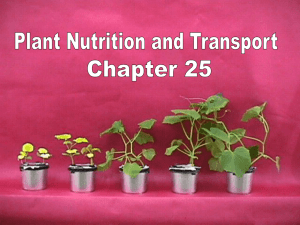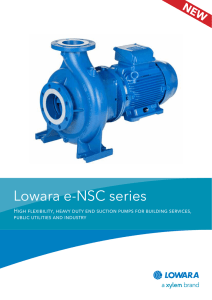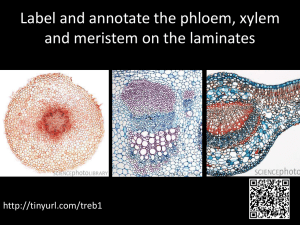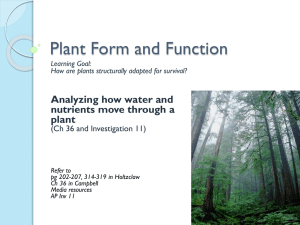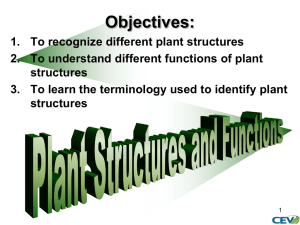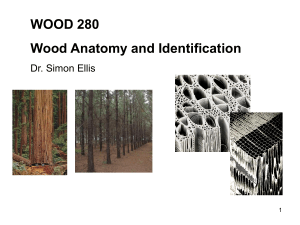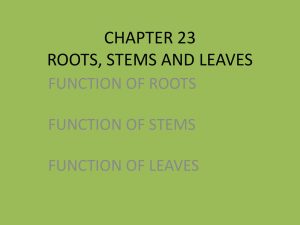waters journey - 15-002
advertisement
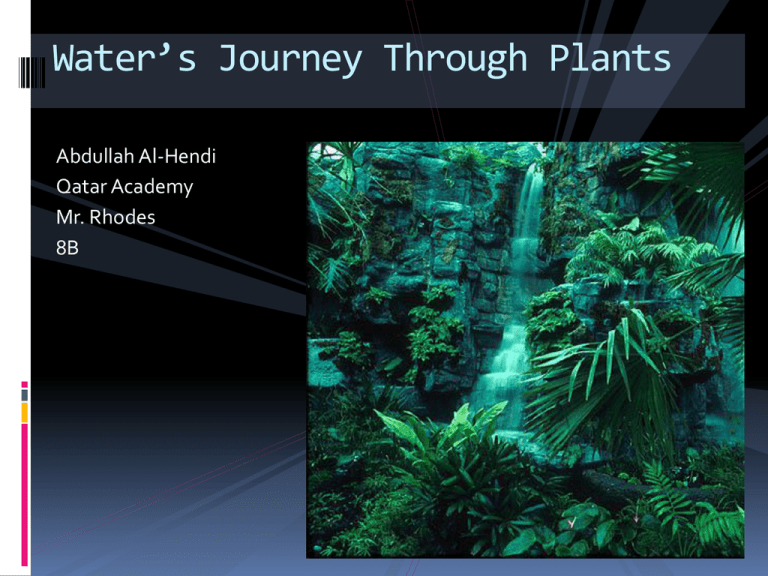
Water’s Journey Through Plants Abdullah Al-Hendi Qatar Academy Mr. Rhodes 8B General Aim . . Is to Understand more on How water enters the plant. How it moves through out the plant. Why the plant needs water to survive And an Overview of a more detailed contents will cover ; How water enters the plant through its roots. TRANSPIRATION . . What it is . . And it’s process. What are XYLEM and PHLOEM and how they transport water and nutrients through the plant and there differences. CHLOROPLASTS's need for water. The process of OSMOSIS. What are ADHESION and COHESION, how they help the movement of water through the plant, and there differences. Water’s Entry The entry of water is through the roots. These roots are the main part of the plants body. The roots are located in the soil beneath the earth’s surface. The absorption of mineral salts and water is mainly through the root hair. These root hairs can be found all around the roots. Water’s Entry: pictures This picture shows the root tip and the root hair located on it. Transpiration The process of transpiration is the the conversion of liquid water into vapor and released into the atmosphere. This process will occur when the stomata on the leafs surface open up to release water vapor. The plant does this because the passage of oxygen (O2) out and carbon dioxide (CO2) in for the plant to produce photosynthesis The water is transported from the roots in liquid form through the xylem into the stems and leaves. Transpiration: Pictures These pictures clearly explain how transpiration works from the First step to the last step. Xylem The responsibility of xylem is to transport mostly water, but also from the roots through the stem and to the leaves. One of its other uses is to replace the loss of water from transpiration. Xylem is one of two transport types in vascular plants. Vascular plants are plants that have certain tissues that can conduct minerals, water, and products that are produced from photosynthesis. Xylem: . . continued The xylem is composed of nonliving, hollow cells. The xylem is a tube in the innermost of the stem. Xylem can only transport water going up the xylem tubes through the plant. Xylem cells support the weight of the plant because of the reinforcements they have on there cell walls. Cross Section: Phloem Tubes in the plant that transports organic nutrients from the leaves to the roots. The cells of the phloem are living. Transports sap that is filled with sugar (glucose) produced by photosynthesis. The sap is sent to locations that are nonphotosynthetic in the plant such as the roots. The phloem can transport these nutrients up and down the plant. Phloem and Xylem differences Xylem Phloem The xylem tissue dies in The phloem is always alive. one year’s time and is created anew. Xylem can only move water upwards the plant. Phloem can transport nutrients upwards and downwards the plant. Xylem and Phloem: Picture This picture shows the differences of the xylem vessel and the phloem vessel and how they transport nutrients and water through the plant. Adhesion and Cohesion Adhesion is the process of any form of attraction between unfamiliar species of molecules. Cohesion is the attraction of like molecules (same specie of molecule). How are they related to Xylem and Phloem Adhesion sticks to the cell walls of the xylem and cohesion attracts like molecules in this case, hydrogen (O2), the water molecules (hydrogen, O2) form a continuous stream of water up the tube. This allows water travel up the xylem tube. After transpiration, the stage of phloem takes place. Adhesion and Cohesion differences Adhesion Cohesion Adhesion attracts Cohesion attracts like unfamiliar molecular species. molecular species . Osmosis Osmosis is the movement of water through the cell membrane… Or, it is the movement of water through a selectively permeable from an area with a large amount of water (Low Concentration) to an area to a low amount of water (High Concentration). It can produce energy and be used for the plant to do work, however it is a passive process. Chloroplasts Chloroplasts are organelles in plant cells that capture light energy and use it to make photosynthesis. Using osmosis water enters the chloroplasts and then is able to react with carbon dioxide (CO2) and create sugar (glucose) and oxygen (O2). The sugars and oxygen are then used to create energy for the plant to survive and continue its life. Chloroplasts: pictures These are chloroplasts from an elodea leaf. This picture shows how chloroplasts take in the sunlight and convert it into energy. Bibliography: Cited Websites "BBC - GCSE Bitesize: Plant Transport." BBC - Homepage. Web. 16 Feb. 2011. <http://www.bbc.co.uk/schools/gcsebitesize/science/add_gateway/greenworld/planttransportrev1.sh tml>. "Plant Structure." Clinton Community College. Web. 16 Feb. 2011. <http://faculty.clintoncc.suny.edu/faculty/michael.gregory/files/bio 102/bio 102 lectures/plant structure/plant structure.htm>. "Phloem." Wikipedia, the Free Encyclopedia. Web. 16 Feb. 2011. <http://en.wikipedia.org/wiki/Phloem>. "Adhesion." Wikipedia, the Free Encyclopedia. Web. 16 Feb. 2011. <http://en.wikipedia.org/wiki/Adhesion>. "Cohesion." Wikipedia, the Free Encyclopedia. Web. 16 Feb. 2011. <http://en.wikipedia.org/wiki/Cohesion>. "What Is the Role of Cohesion and Adhesion in Water Movement within Plants? -Yahoo! Answers." Yahoo! Answers - Home. Web. 16 Feb. 2011. <http://answers.yahoo.com/question/index?qid=20100304194541AAvqVq2>. "Biology4Kids.com: Plants: Xylem and Phloem." Rader's BIOLOGY 4 KIDS.COM. Web. 16 Feb. 2011. <http://www.biology4kids.com/files/plants_xylemphloem.html>. "Biology4Kids.com: Cell Function: Passive Transport." Rader's BIOLOGY 4 KIDS.COM. Web. 16 Feb. 2011. <http://www.biology4kids.com/files/cell2_passivetran.html>. "Osmosis." Wikipedia, the Free Encyclopedia. Web. 16 Feb. 2011. <http://en.wikipedia.org/wiki/Osmosis#Basic_explanations>.



